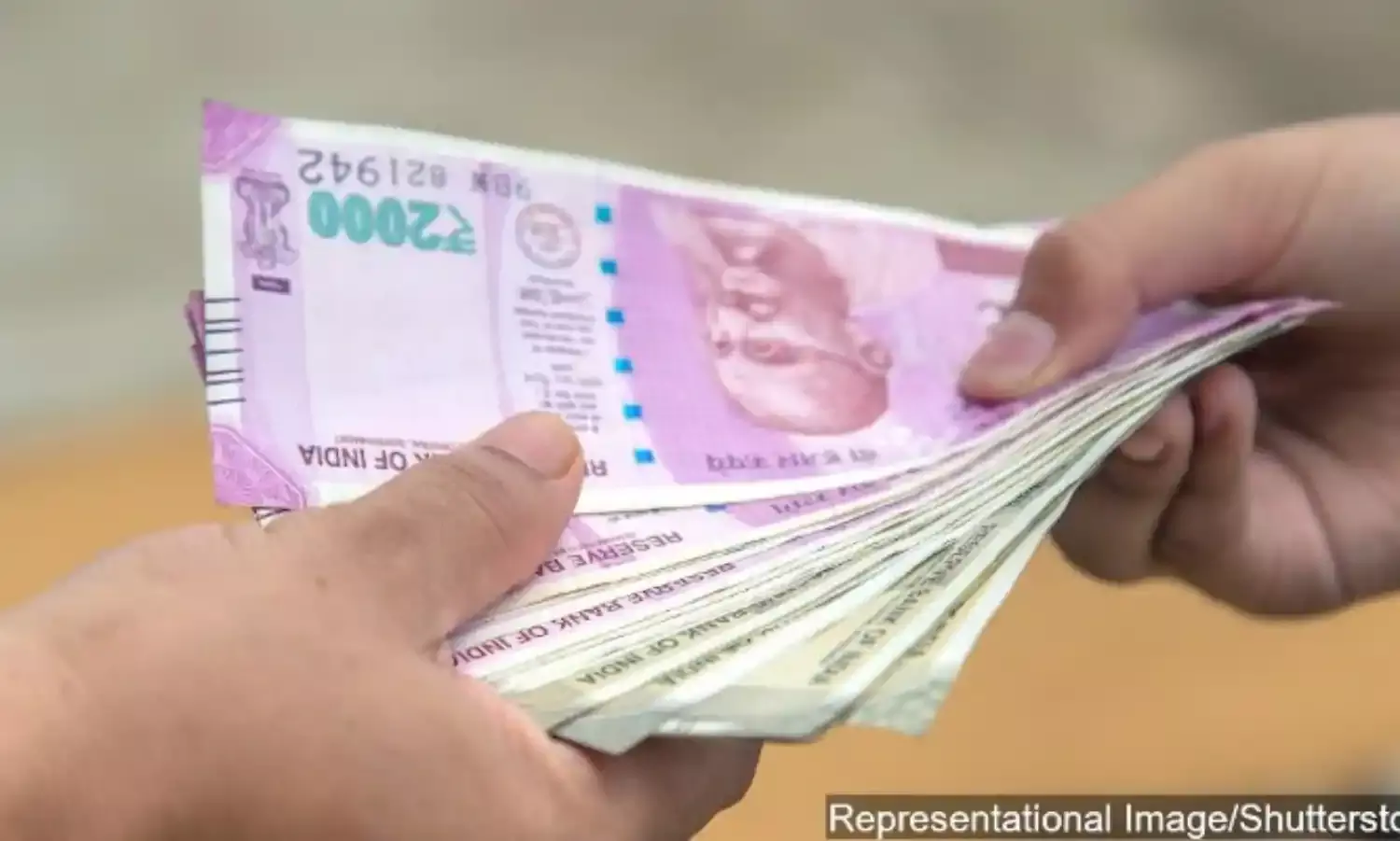‘ரூபாய் நோட்டுக்கும் கோவிட் -19 பரவுதலுக்குமான தெளிவான தொடர்பு இல்லை’

மும்பை: இந்தியாவின் பணத்திற்கான அதிக தேவையில் -சமீபத்திய கணக்கெடுப்பின்படி கிட்டத்தட்ட 94% பரிவர்த்தனைகள் ரொக்கமாகவே நடந்துள்ளன - கோவிட்-19 பரவுவதில் குறிப்பிடத்தக்க தாக்கங்களை ஏற்படுத்த வாய்ப்பில்லை. ஏனென்றால், புழக்கத்தில் இருக்கும் தனிநபர் ரூபாய் நோட்டு மதிப்பின் அளவிற்கும், நாடுகளில் வைரஸ் பரவும் விகிதங்களுக்கும் இடையே பலவீனமான தொடர்பு உள்ளதாக, சமீபத்திய உலகளாவிய தரவுகளின் பகுப்பாய்வு காட்டுகிறது.
மார்ச் 16, 2020 அன்று, அதாவது ஊரடங்கை நோக்கி நாடு சென்று கொண்டிருந்த வாரத்தில், கோவிட் வைரஸ் பரவுவதைத் தடுக்க, பணமில்லா பரிமாற்ற கட்டண முறைகளை பயன்படுத்தும்படி இந்திய ரிசர்வ் வங்கி பரிந்துரைத்தது. உலக சுகாதார அமைப்பு (WHO) ஆலோசகர்கள் மற்றும் உலகம் முழுவதும் உள்ள மத்திய வங்கிகளின் பண நோட்டுகள் வாயிலாக கொரோனா வைரஸ் அல்லது SARS-CoV-2 பரவ வாய்ப்புள்ளதாக அறிவுறுத்தியபோது பணப்பயன்பாட்டை சுற்றியுள்ள தொடர்பு, ஒரு பெரிய பிரச்சினையாக மாறியது.
புழக்கத்தில் உள்ள பண நோட்டுகளுக்கும் கோவிட்-19 பரவலுக்கும் இடையிலான இந்த தொடர்பை அறிய, 2018ம் ஆண்டு நிலவரப்படி கரன்சி புழக்கத்தில் உள்ள நாடுகளுக்கு இடையேயான தொடர்புகளை ஆராய்ந்தோம்; அத்துடன், ஜூலை 15 ஆம் தேதி நிலவரப்படி கோவிட்-19 வழக்குகளை உறுதிப்படுத்தினோம். கீழேயுள்ள எண்ணிக்கை ஒரு நாட்டில் 10 லட்சம் நபர்களுக்கு மொத்த நோய்வழக்குகளுக்கு தனிநபர் கரன்சியை (நூற்றுக்கணக்கான அமெரிக்க டாலர்களை பொறுத்தவரை) திட்டமிடுகிறது. (இது இறப்பு குறித்த எந்தவொரு கருத்தையும் அனுமதிக்காது; இது அறிக்கை தரப்பட்ட தொற்று விகிதங்களை அடிப்படையாகக் கொண்டது; சோதனை இல்லாததால் இது குறைத்து மதிப்பிடப்படலாம்).
நாம் ஒரு மாற்று நடவடிக்கையை பார்த்தபோது -கரன்சி -மொத்த உள்நாட்டு உற்பத்தி (GDP) விகிதத்திற்கும் ஒரு மில்லியன் பேரில் மொத்த வழக்குகளுக்கும் இடையிலான எந்த தொடர்பும் இல்லை. எடுத்துக்காட்டாக, ஸ்வீடனில், இந்த விகிதம் 1.3% (2018 நிலவரப்படி) மற்றும் ஒரு மில்லியனுக்கு மொத்த வழக்குகள் 2,186; இந்தியாவில் இந்த விகிதம் 11.2% ஆக உள்ளது; ஆனால் ஒரு மில்லியனுக்கு மொத்த வழக்குகள் 29 ஆகும். அமெரிக்கா மற்றும் ஐரோப்பிய நாடுகள் என தொற்றுநோயால் மோசமாக பாதிக்கப்பட்டுள்ள பகுதிகளில், அந்த நாடுகளுக்கு வெளியே ஒரு பெரிய பகுதி பணம் உள்ளது; எனவே, உள்நாட்டு தொற்று விகிதங்களுடன் அது தொடர்புடையதாக இருக்காது.
கொரோனா வைரஸ் நாவலின் புதிய பரவல் முறை குறித்து எந்த தகவலும் கிடைக்கவில்லை என்றாலும், ஜெர்மனியில் மருத்துவ ஆராய்ச்சியாளர்கள் குழு தொகுத்த அறிவியல் ஆய்வுகள், பிப்ரவரி 2020 இல் சில பரிந்துரைகளை தந்தன; அதாவது காகிதம், பிளாஸ்டிக் மற்றும் கண்ணாடி மேற்பரப்புகளில் வைரஸ் (4-5 நாட்கள், அதன் திரிபு வகையை பொறுத்து)உயிர்வாழும் என்பதாகும். மார்ச் 2020 இல் எம்.ஐ.டி. டெக்னாலஜி மதிப்புரை கட்டுரையில், இணை ஆசிரியர் மைக் ஆர்கட் உலக சுகாதார அமைப்பின் ஆலோசனைக்கு பதில் அளித்திருந்தார். அதில். கடைக்காரர்கள் இந்த நோயை மற்றவர்களிடம் இருந்து நோய்த்தொற்று நோயால் பாதிக்க வாய்ப்புள்ளது என்பதை சுட்டிக்காட்டினார்.
அமைப்புசாரா துறையே பெரும் பங்கை கொண்டுள்ள நிலையில் அங்கு பணமில்லா கட்டண பரிமாற்ற முறை குறைவாக பின்பற்றப்படுகிறது. எனவே, இத்தகைய பணப்பயன்பாட்டைக் கட்டுப்படுத்துவது சிக்கல்களை உருவாக்கக்கூடும்; குறிப்பாக தொற்றுநோய் காலத்தில் வாழ்வாதாரம் தொடர்பான நிச்சயமற்ற தன்மையை எதிர்கொள்ளும் ஏராளமான புலம்பெயர்ந்த தொழிலாளர்களுக்கு நெருக்கடியைத் தரும். இந்தியாவின் பணப்பயன்பாடு அதன் பெரிய முறைசாரா துறையின் அளவோடு இணைக்கப்பட்டுள்ளது; இது அதன் தேசிய வருமானத்திற்கு 50%-க்கும் அதிகமாக பங்களிக்கிறது.
டச் மொபைல்போன் அல்லது பாயிண்ட்-ஆஃப்-சேல் (PoS) கருவி போன்ற டிஜிட்டல் முறைகளில் உள்ள ஆபத்துகளையும் எங்களது கண்டுபிடிப்பு நிராகரிக்காது; ஆனால் உலகம் முழுவதும் உள்ள மத்திய வங்கிகள் கோவிட் தொற்றுக்கு பிறகு உலகில் கட்டண முறைகளில் ஏற்படும் மாற்றங்களுக்கேற்ப மாற்ற வேண்டியதன் அவசியத்தை இது வலியுறுத்துகிறது - எடுத்துக்காட்டாக, ‘tap-and-go’ தொகை பரிமாற்றம் அல்லது டிஜிட்டல் கரன்சிகளின் பயன்பாடு.
பணத்தின் மீதான ஒரு சந்தேகம்
இந்த தொற்றுநோய் மக்களை பணம் வாயிலாக பரவுமோ என்ற எச்சரிக்கையை ஏற்படுத்தி இருக்கிறது; உலகம் முழுவதும் உள்ள மத்திய வங்கிகள் பணம் மீதான நம்பிக்கையை அதிகரிக்க வேண்டும் என்று நிதி ஆய்வாளர்களான ரபேல் அவுர், கியுலியோ கார்னெல்லி மற்றும் ஜான் ஃப்ரோஸ்ட் ஆகியோரால் எழுதப்பட்ட சர்வதேச செட்டில்மென்ட்ஸ் வங்கியின் (BIS- பிஐஎஸ்) 2020 ஏப்ரல் அறிக்கை தெரிவித்தது.
"நாணய தேவையைப் படிக்க பொருளாதார வல்லுநர்கள் பயன்படுத்தும் இரண்டு நடவடிக்கைகள் உள்ளன: மொத்த உள்நாட்டு உற்பத்தி (ஜிடிபி) விகிதத்திற்கான நாணயம் மற்றும் தனிநபர் புழக்கத்தில் உள்ள நாணயம்,” என்று, பம்பாய் (IITB - ஐ.ஐ.டி.பி) இந்திய தொழில்நுட்ப நிறுவனத்தின் மனிதநேயம் மற்றும் சமூக அறிவியல் துறையின் பொருளாதார பேராசிரியர் புஷ்பா எல் திரிவேதி கூறினார். இந்தியா, ஹாங்காங் மற்றும் ஜப்பான் போன்ற நாடுகள், மற்ற பொருளாதார முறைகளை விட முதலாவது நடவடிக்கை காரணமாக பணப்பரிமாற்ற முறையையே நம்பியுள்ளன; மாற்று விகிதங்களில் உள்ள வேறுபாடுகள் காரணமாக பிந்தையது அவசியமில்லை. எடுத்துக்காட்டாக, இந்தியாவில், தனிநபர் புழக்கத்தில் கிட்டத்தட்ட 13,500 ரூபாய் (230 டாலர்) உள்ளது, ஆனால் அமெரிக்கா 2018 ஆம் ஆண்டு நிலவரப்படி தனிநபர் $ 5,000 க்கும் அதிகமான புழக்கத்தில் உள்ளது; இந்த உண்மைப்படி பார்த்தால் இந்தியாவை விட பண பரிமாற்றத்தை அமெரிக்கா அதிகம் நம்பியிருப்பதாக ஒருவர் நினைக்கலாம்.
பணப்பயன்பாடு குறித்த அணுகுமுறைகள் மற்றும் உணர்வுகள் நாடுகளுக்கு நாடு பரவலாக வேறுபடுகின்றன என்று மெல்போர்ன் பல்கலைக்கழகத்தின் வணிக மற்றும் பொருளாதார விரிவுரையாளர் மெஹ்மத் ஓஸ்மென் கூறினார். எடுத்துக்காட்டாக, மத்திய வங்கியாளர் ஜான் பக்னால் மற்றும் அவரது சகாக்கள் தங்கள் 2016 ஆம் ஆண்டு மத்திய வங்கியின் சர்வதேச பத்திரிகையில் வெளியிட்டுள்ள ஆய்வறிக்கையில், கனடாவில் பரிவர்த்தனைகளுக்கான டெபிட் கார்டுகளுடன் ஒப்பிடும்போது பணம் மிகவும் ஏற்றுக்கொள்ளத்தக்கதாக கருதப்படுகிறது, ஆனால் அமெரிக்காவில் அவ்வளவு இல்லை என்பதாகும்.
"அமெரிக்கா, கனடா, ஆஸ்திரேலியா, பிரிட்டன் போன்ற நாடுகள் தங்கள் குடிமக்கள் எவ்வாறு பணம் மற்றும் டெபிட் மற்றும் கிரெடிட் கார்டுகள் போன்ற பிற கட்டண முறைகளைப் பயன்படுத்துகின்றன என்பது குறித்து விரிவான கணக்கெடுப்புகளை வழக்கமாக நடத்துகின்றன" என்று ஓஸ்மென் கூறினார். "இந்தியாவில் பணம் செலுத்துவதற்கான வாய்ப்புகளை இயக்க அதிக ஆதாரங்கள் இல்லை" என்றார். மும்பையில் பணம் செலுத்தும் முறை மற்றும் பணப்பயன்பாடு குறித்த தனது ஆய்வில், பதிவான கிட்டத்தட்ட 15,000 பரிவர்த்தனைகளில் 94% ரொக்கமாக மேற்கொள்ளப்பட்டிருப்பதை அவர் கண்டறிந்தார்; இதில் பொதுவாக ரூ.500-க்கும் குறைவான பரிவர்த்தனைகள் இருந்தன.
இந்தியாவில் பணத்திற்கான தேவையை பாதிக்கும் சில காரணங்களை ஆராய்ந்ததில், சமீபத்திய ஆய்வுகள் நாணயத்தில் இருந்து மொத்த உள்நாட்டு உற்பத்தியின் விகிதத்தை தீர்மானிக்கும் மாற்று கட்டணக் கருவிகள் கிடைப்பதை சுட்டிக்காட்டுகின்றன. டிஜிட்டல் மாற்று வழிகள் கிடைக்கும்போது தொற்றுநோய் காலத்தில் பணத்தைத் தவிர்க்குமாறு பரிந்துரைக்கும் அரசின் ஆலோசனைகள் நல்ல நோக்கங்களை கொண்டிருக்கலாம்; ஆனால் பகுப்பாய்வு காட்டியபடி அது ஊகமாக இருக்கலாம்.2020 மே மற்றும் ஜூன் மாதங்களுக்கான பணப்பரிமாற்றங்கள் குறித்த மொத்த தகவல்கள் இந்திய ரிசர்வ் வங்கியால் இன்னும் வெளியிடப்படவில்லை; ஆனால் ஏப்ரல் 2020 வரையிலான தரவு, டிஜிட்டல் பணப்பரிமாற்றங்களில் சரிவு மற்றும் ஏடிஎம்-களில் பணம் பெறுவது குறைந்ததை தெரிவித்துள்ளது. மேலும், இந்தியன் நேஷனல் பேமெண்ட் கார்ப்பரேஷன் (NPCI- என்.பி.சி.ஐ) சமீபத்தில் வெளியிடப்பட்ட தகவல்கள், முந்தைய மாதங்களுடன் ஒப்பிடும்போது, மார்ச் 2020 இல் ஒட்டுமொத்த மொபைல் மற்றும் டிஜிட்டல் பணப்பரிமாற்றங்களில் சரிவை காட்டின. நாடு தழுவிய ஊரடங்கு அறிவிக்கப்பட்ட மார்ச் 24 முதல் பொருளாதார நடவடிக்கைகளின் ஒட்டுமொத்த வீழ்ச்சியால் இதை விளக்க முடியும். ஏடிஎம் வாயிலாக பணம் எடுப்பதில் சரிவு ஊரடங்கின் போது நீடித்த கட்டுப்பாடுகள் காரணமாக இருக்கலாம் என்று திரிவேதி கூறினார்.
ஏ.டி.எம்.களில் பணம் எடுப்பவர்களின் எண்ணிக்கை (பெரும்பாலும் டெபிட் கார்டுகளைப் பயன்படுத்துகிறது) 2020 ஜனவரியில் 65.7 கோடியில் இருந்து 2020 ஏப்ரலில் 28.7 கோடியாக குறைந்தது.
முன் உள்ள வழி
கோவிட்டுக்கு பிந்தைய உலகில் ரொக்க பரிமாற்றத்திற்கு என்ன நடக்கும்?உதாரணமாக, அமெரிக்காவில் பல கிரெடிட் கார்டு நிறுவனங்கள் தொற்றுநோய்களின் போது ரொக்க முறையில் இருந்து விலகி இன்னும் கட்டமைப்பு மாற்றத்தை ஏற்படுத்தும் வாய்ப்பை உருவாக்கின. கொரோனா வைரஸ் கிரெடிட் / டெபிட் கார்டுகள் அல்லது மொபைல்போன் தொடுதிரை மேற்பரப்புகளில் இருப்பதை விட காகித பணத்தின் மேற்பரப்புகளில் நீண்ட நேரம் இருக்கக்கூடியவை என்ற அனுமானத்தின் அடிப்படையில் இது கணிக்கப்பட்டுள்ளது.
கோவிட்-19 ஆல் பாதிக்கும் மேற்பரப்புகளுக்கு மிகவும் பயனுள்ள கிருமிநாசினிகளில் எத்தனாலும் ஒன்று என, ஆய்வுகள் தெரிவிக்கின்றன. இந்தியா இன்னும் காகித அடிப்படையிலான நாணயத்தாள்களைப் பயன்படுத்துவதால், பொதுமக்கள் மத்தியில் புழக்கத்தில் உள்ள பெரிய அளவிலான ரூபாய் நோட்டுகளை கிருமி நீக்கம் செய்வது நடைமுறையில் கடினமாக இருக்கலாம். கனடா, இங்கிலாந்து மற்றும் சுவிட்சர்லாந்து போன்ற நாடுகளில் (மற்றும் பிற ஐரோப்பிய ஒன்றிய நாடுகள், எனினும் அமெரிக்காவில் அல்ல) பாலிமர் அடிப்படையிலான ரூபாய் நோட்டுகள் உள்ளன; அவை பணத்தாளின் ஆயுளை பாதிக்காமல் கிருமி நீக்கம் செய்ய எளிதாக இருக்கும். இந்தியா, கடந்த காலத்தில், இத்தகைய வாய்ப்புகளை ஆராய்ந்தது.
(தாகத், மும்பை ஐ.ஐ.டி.பி-மோனாஷ் ஆராய்ச்சி அகாடமியில் பி.எச்.டி அறிஞர் ஆவார். இக்கட்டுரையில் தெரிவிக்கப்பட்டுள்ள கருத்துகள் ஐ.ஐ.டி பம்பாய், மோனாஷ் பல்கலைக்கழகம், அகாடமி அல்லது இந்த ஆராய்ச்சி ஏற்பாட்டாளருடையதாக குறிக்கவில்லை).
உங்களின் கருத்துகளை வரவேற்கிறோம். கருத்துகளைrespond@indiaspend.org. என்ற முகவரிக்கு அனுப்பலாம். மொழி, இலக்கண நடை கருதி அவற்றை திருத்தும் உரிமை எங்களுக்கு உண்டு.

